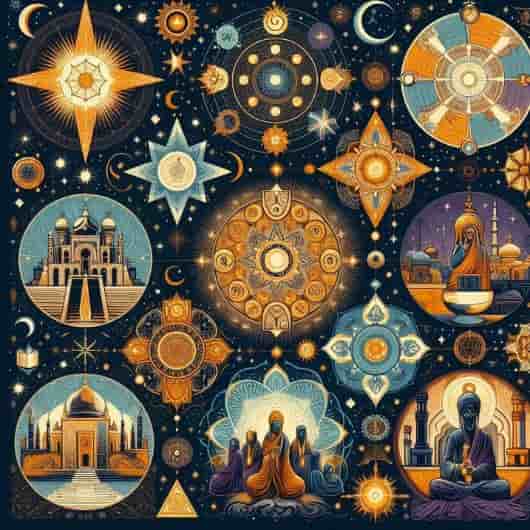The Symbolism and Spiritual Meaning of Stars

Stars have captivated humans for millennia. They light up the night sky and inspire wonder. Ancient cultures saw stories in the stars. Many believed they were divine. Today, stars still hold deep spiritual meaning for people around the world.
Stars are more than just balls of gas burning billions of miles away. To many, they represent hopes, dreams, and the mysteries of the universe. They’ve guided travelers and inspired philosophers. Stars have been important symbols in art, literature, and religion for centuries.
The General Spiritual Meaning and Symbolism of Stars

For centuries, people have looked to the stars for guidance and inspiration. Stars are often seen as divine or supernatural. They represent things that are larger than ourselves. Here are some of the most common spiritual meanings associated with stars:
- Divine guidance and direction: Stars have long been used for navigation. Travelers would use the position of the stars to find their way. Spiritually, stars can represent a higher power guiding us through life.
- Hope and inspiration: The light of stars pierces the darkness of night. They can be symbols of hope shining through dark times. Stars also inspire us to dream big and reach high.
- Enlightenment and wisdom: Stars are associated with higher knowledge and truth. Some believe that contemplating the stars can lead to a deeper understanding of the universe and our place in it.
- Celestial protection and guardianship: In some traditions, stars are seen as celestial protectors watching over us. They can represent guardian angels or ancestors looking out for us from above.
Stars have a special place in many spiritual and religious traditions. Across cultures, stars often symbolize a connection between heaven and earth. They represent a bridge between the physical and spiritual realms.
Some see stars as the dwelling places of gods, angels, or other celestial beings. Others believe stars are the souls of the dead who have taken their place in the heavens. Still others see stars as the source of all life and creation.
| Spiritual Meaning | Symbolism |
|---|---|
| Divine guidance | Stars used for navigation, representing higher power guiding us |
| Hope and inspiration | Starlight piercing darkness, encouraging us to dream big |
| Enlightenment and wisdom | Stars associated with higher knowledge and truth |
| Celestial protection | Stars seen as guardian angels or ancestors watching over us |
Stars in Different Spiritual and Cultural Traditions

Stars have held immense significance across various spiritual and cultural traditions throughout human history. Their interpretation and symbolism have varied greatly, reflecting the diverse perspectives and beliefs of different civilizations.
Ancient Civilizations
The ancient Egyptians associated stars with their belief in an afterlife. They saw stars as the eternal souls of the deceased, shining brightly in the night sky. The bright star Sirius, also known as Sopdet, held great importance, marking the beginning of the Nile flood and the new year.
For the ancient Greeks, stars represented knowledge, inspiration, and divine guidance. Each star embodied a unique aspect of the gods’ wisdom and power. Constellations depicted mythological figures and events, becoming an integral part of Greek mythology.
The ancient Chinese viewed stars as a connection between Earth and the heavens, symbolizing spiritual energy and cosmic harmony. They believed that the alignment of stars during one’s birth influenced personality traits and life’s destiny.
Abrahamic Religions
In Judaism, Christianity, and Islam, stars hold a special place in religious beliefs and practices.
The Hebrew Bible contains references to stars, both literal and figurative. Stars are often used to symbolize divine guidance, hope, and the concept of the soul or spirit.
In Christianity, the Star of Bethlehem is a powerful symbol, representing the divine guidance that led the Magi to the birthplace of Jesus Christ. The five-pointed star, or pentagram, symbolizes the five wounds of Jesus during his crucifixion.
In Islam, stars are seen as manifestations of God’s glory and existence. The Quran references stars as signs of God’s creation and guidance for navigation. Stars are also believed to act as barriers, protecting the faithful from demonic entities.
Eastern Spiritual Traditions
Stars play a significant role in Hinduism, Buddhism, and Taoism.
In Hinduism, stars are often seen as glinting representations of divine beings or deities, guiding and protecting those they watch over. They can also indicate femininity, beauty, and motherhood.
Buddhism associates stars with symbols of enlightenment and the impermanence of existence. The concept of stars as the abodes of deities and the souls of ancestors is also prevalent.
Taoism views stars as manifestations of the Tao and the harmony of the universe. Stars are believed to be sentient bodies, endowed with spirit and acting with God’s permission.
Stars as Providers of Spiritual Guidance and Messages

Across cultures, stars have been revered as sources of spiritual guidance and divine messages. Their movements and alignments have been interpreted as signs from higher powers, offering direction and insight into life’s journey.
The belief that stars can offer guidance and wisdom is deeply rooted in many traditions. Stars have long been used for navigation, guiding travelers across vast distances. This practical application has been extended to the spiritual realm, with stars seen as celestial guides illuminating the path of spiritual seekers.
One common practice is interpreting the movement and alignment of stars as divine messages. Certain star patterns or celestial events are believed to convey specific meanings or portents, offering guidance on important decisions or foretelling future events.
Many cultures encourage practices such as stargazing meditation, intention-setting under starry skies, and astral projection visualizations. These rituals aim to attune individuals to the guidance and wisdom emanating from the stars, fostering a deeper connection with the cosmic realm.
Looking for more insights? Read these posts.
The Significance of Stars in Astrology
Astrology, the study of the movements and relative positions of celestial bodies and their influence on human affairs and natural phenomena, has been practiced across cultures for millennia. Stars play a central role in this ancient practice.
In astrological systems, stars are believed to exert influence on personality traits, life events, and relationships. The positioning of stars at the time of an individual’s birth is thought to shape their destiny and compatibility with others.
One of the fundamental concepts in astrology is the natal chart, which maps the positions of stars and planets at the exact time and location of a person’s birth. Astrologers interpret these celestial alignments to gain insights into an individual’s character, strengths, challenges, and life path.
The zodiac, a belt of constellations through which the Sun, Moon, and planets appear to move, is a crucial component of astrology. Each of the 12 zodiac signs is associated with specific traits and influences, believed to shape various aspects of an individual’s life.
While the scientific validity of astrological predictions remains debated, the symbolic and metaphorical significance of stars in astrology cannot be denied. Astrology has endured as a means of exploring the human experience and our connection to the cosmos.
Stars and Their Connection to Divine or Celestial Beings
In many spiritual and religious traditions, stars are seen as representations or abodes of divine beings, celestial entities, or the souls of the departed. This connection between stars and the divine realm has shaped beliefs, myths, and practices across cultures.
In ancient Greek mythology, stars were believed to be the dwelling places of gods and heroes. Constellations were named after mythological figures, serving as visual representations of their narratives.
Similarly, in Hinduism, stars are often associated with deities or divine beings, believed to guide and protect those they watch over. The concept of stars as the abodes of gods and goddesses is deeply ingrained in Hindu scriptures and beliefs.
In some indigenous American cultures, stars were revered as the eternal souls of ancestors, shining brightly in the night sky and watching over their living descendants. This belief fostered a deep connection between the celestial realm and the earthly realm.
The idea of stars as celestial protectors or guardians is also prevalent in various traditions. Stars are seen as sentinels, guiding and shielding individuals from harm or negative influences.
Many spiritual practices involve communicating with celestial beings through starlight meditation or rituals. The belief is that by connecting with the energy and wisdom of stars, one can tap into the divine realm and receive guidance or blessings from celestial entities.
The Metaphysical and Energetic Properties of Stars

Stars have long been revered for their metaphysical and energetic properties. Many spiritual traditions believe that stars possess powerful energies that can influence our lives and aid in personal growth and healing.
Starlight Meditation
One of the most common practices involving the metaphysical properties of stars is starlight meditation. This practice involves focusing on the energy and light of stars during meditation. Practitioners believe that by connecting with the wisdom and guidance of stars, they can tap into a higher state of consciousness and receive spiritual insights.
The process typically involves visualizing starlight filling and healing the body. Some believe that starlight carries specific frequencies or vibrations that can help align and balance the chakras, promoting emotional well-being and spiritual growth.
Star Essences and Talismans
Another way to harness the energies of stars is through the creation of star-infused essences or talismans. This involves capturing or infusing the energy of starlight into objects, such as oils, crystals, or jewelry.
These essences or talismans are believed to carry the metaphysical properties of the stars they were infused with. They can be used for various purposes, such as spiritual healing, protection, or manifesting desires.
Some practitioners create star essences by exposing water or oils to starlight during specific astrological events or celestial alignments. Others may incorporate star symbolism or materials associated with specific stars into the creation of talismans.
Connecting with Celestial Beings
In certain spiritual traditions, stars are seen as representations or abodes of celestial beings, such as gods, angels, or spirit guides. Practices like starlight meditation or working with star essences are believed to facilitate communication with these celestial entities.
The belief is that by connecting with the energy and wisdom of stars, individuals can receive guidance, protection, or blessings from these higher realms. This connection is often sought for personal growth, spiritual development, or seeking answers to life’s challenges.
Stars in Dreams and Their Interpretation
Stars have long held symbolic significance in dreams, with their appearance often carrying profound meanings and messages. Dream interpretation is a complex and nuanced practice, but some common themes and symbolism associated with stars in dreams can provide insight into their potential meanings.
One of the most common interpretations of stars in dreams is that they represent hopes, aspirations, and desires. Bright, shining stars may symbolize positive omens, success, or the fulfillment of wishes. On the other hand, falling or shooting stars could represent fleeting opportunities or missed chances.
The color and behavior of stars in dreams can also hold specific symbolism. For example, stars of different colors may represent various emotions or aspects of one’s life, with each color carrying its unique symbolism.
Stars forming patterns or constellations in dreams may convey messages or lessons related to the specific constellation’s meaning. These patterns could represent guidance or insights from a higher power or one’s subconscious mind.
Stars in dreams can symbolize spiritual connection, enlightenment, or a desire for higher knowledge. They may represent a longing to understand one’s place in the universe or a need for guidance on one’s spiritual journey.
The spiritual meaning and symbolism of stars reflect humanity’s eternal quest for understanding and transcendence. From ancient civilizations to modern spiritual traditions, stars have been venerated as beacons of guidance, representations of celestial beings, and sources of profound wisdom. As we gaze upon their twinkling light, may we find solace, inspiration, and a deeper appreciation for the wonders of the universe.
Sources






